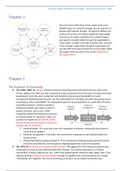Samenvatting
Summary Purchase Supply Management - Strategic Supply Management Principles, Theories and Practices, 2008.
- Instelling
- Universiteit Twente (UT)
Strategic Supply Management Principles, Theories and Practices, 2008. Chapters 1 to 19, excluding 10 and 15.
[Meer zien]





